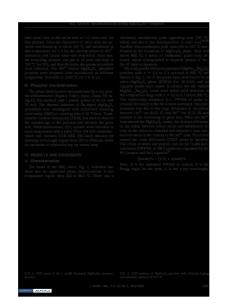LaPO 4 :Eu 3+ Nanowires Luminesce More Efficiently than Dots
- PDF / 1,040,977 Bytes
- 1 Pages / 612 x 792 pts (letter) Page_size
- 100 Downloads / 252 Views
the floating gate makes the structure more tolerant to defects in the tunnel oxide and therefore reduces leakage. This permits the use of thinner tunnel oxides, which in turn reduces the operating voltage, improves endurance and retention, and increases the write/erase rate. To fabricate their devices, the researchers took advantage of the fact that tungsten silicide on SiO2 forms elemental tungsten when thermally oxidized. As described in the March issue of Electrochemical and SolidState Letters (p. G71), the team began by growing a 4.5 nm tunnel oxide on silicon substrates, followed by sputter deposition of 8 nm of W5Si3 for the floating gate and 10 nm of amorphous silicon. A thermal oxidation step formed the control oxide and the elemental W in the SiO2 matrix. The W particles had an average diameter of 4.5 nm and an areal density of 3.7 × 1011 cm–2. Fourier transform infrared spectroscopy analysis showed that elemental tungsten was clearly present, with little or no tungsten oxide formation. The researchers used capacitance–voltage measurements to demonstrate the electron charging effect of their W particles. A bidirectional voltage sweep from 3 V to –4 V and back to 3 V yielded a shift in the threshold voltage ∆Vt of 0.95 V, which is sufficient for binary switching. The researchers found that there was no appreciable decrease in ∆Vt until after 106 cycles and in fact, after 109 cycles, ∆Vt had only dropped to 0.71 V. The operating characteristics of the W nanoparticle EEPROMs represent an improvement over both the high 7 V operating voltage of conventional floating gate devices and the rapid drop-off seen in the endurance of other nanoparticle devices. In addition, this silicide technique is easily integrated with existing semiconductor technology, making the W nanocrystal devices viable competitors to conventional EEPROMs. AMANDA GIERMANN
In the January issue of the Journal of American Ceramic Society (p. 243; DOI: 10.1111/j.1551-2916.2004.00041.x), researchers Yujiro Watanabe of Hosei University, Japan, and Toshiyuki Ikoma of the National Institute for Materials Science, Japan, and colleagues reported a sintering process for producing dense, transparent, and highly oriented crystalline HAp bodies. The researchers first prepared the HAp powder by reacting Ca(OH)2 with H3PO4 solution, followed by spray drying and then calcining at 800°C for 3 h. Sintering of the HAp sample was carried out by pulsed electric current sintering (PECS) in a spark plasma sintering (SPS) system. In the PECS process, powder particles are charged with electrical energy and a high pressure is applied on the sample. During the sintering of HAp, the sample was pressed uniaxially at 50 MPa in vacuum. The sintering temperature was elevated at a rate of 50°C/min to 1200°C. After maintaining the temperature for 10 min, the sample was slowly cooled to 600°C at a rate of 5°C/min. The electric current was then stopped, the pressure was released, and the sample was cooled to room temperature. The resulting bulk sample has high optical transmitt
Data Loading...











